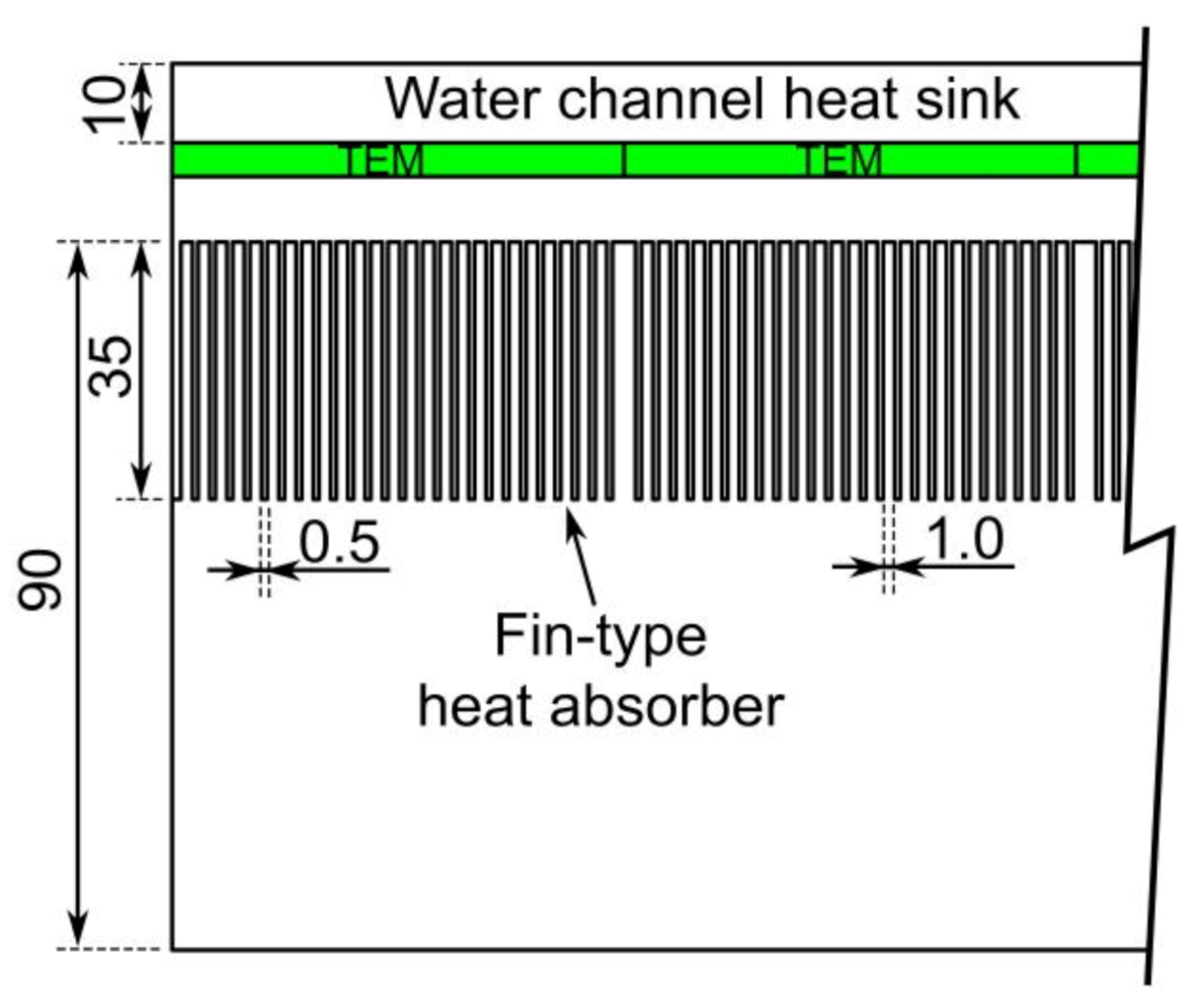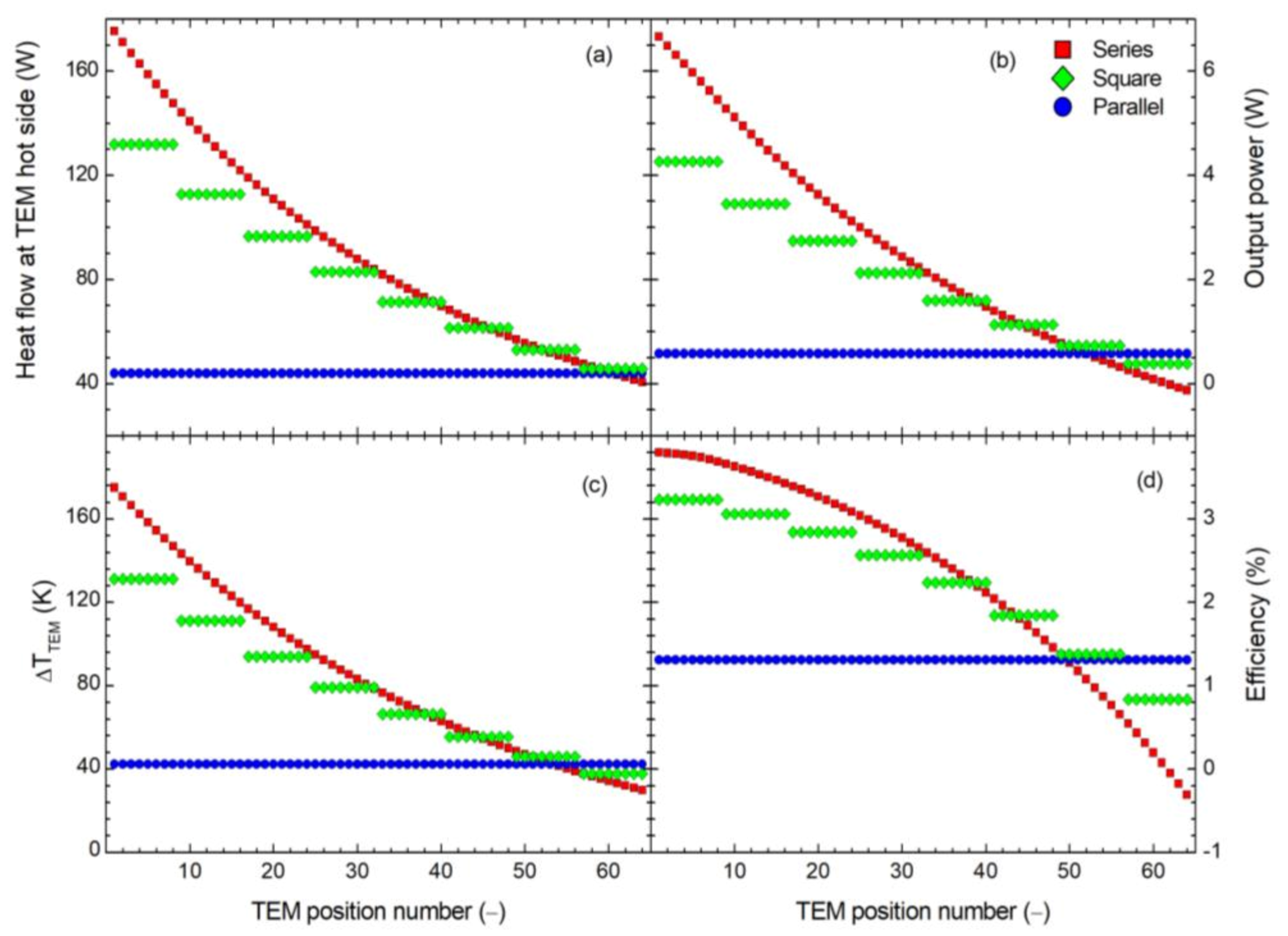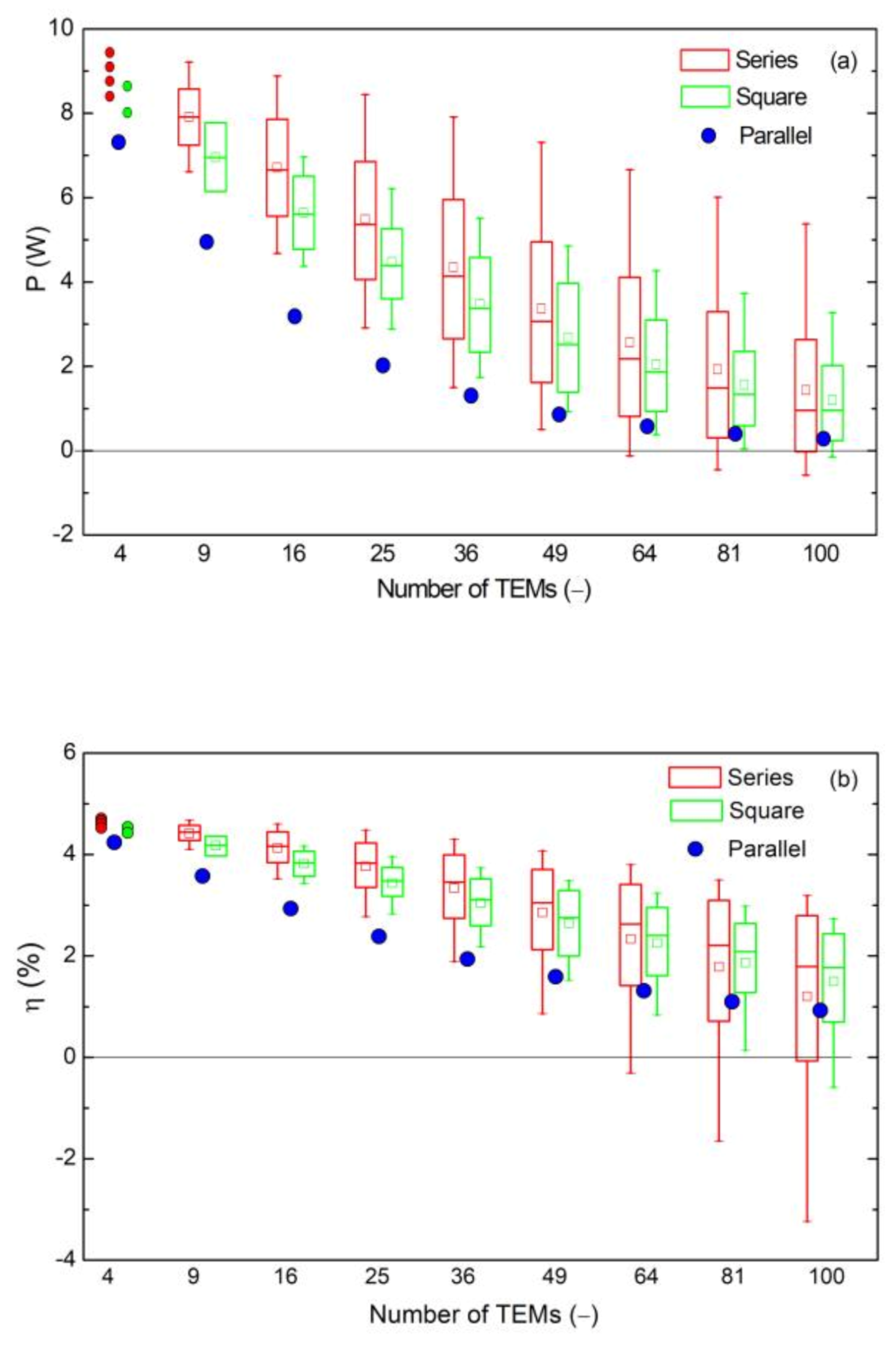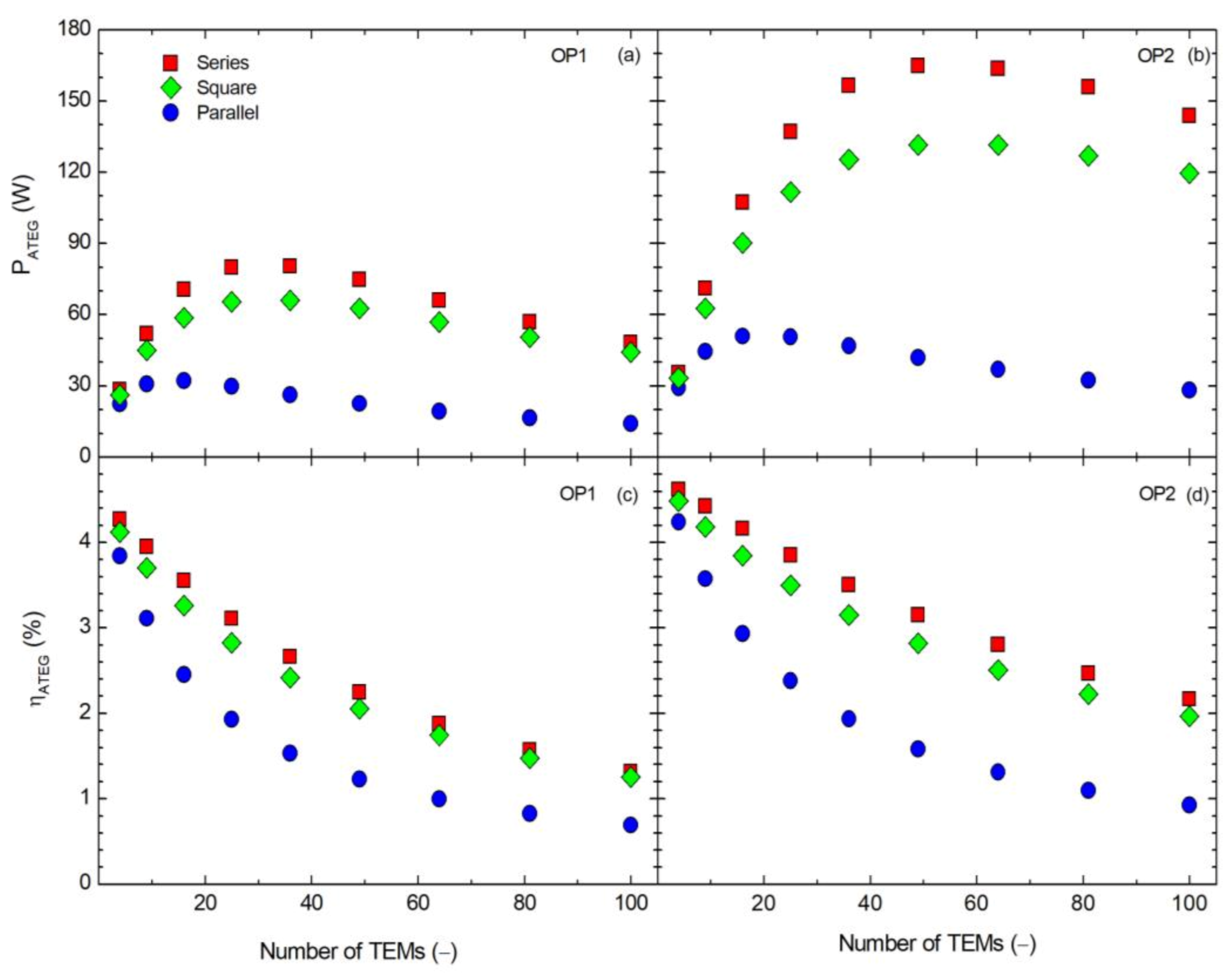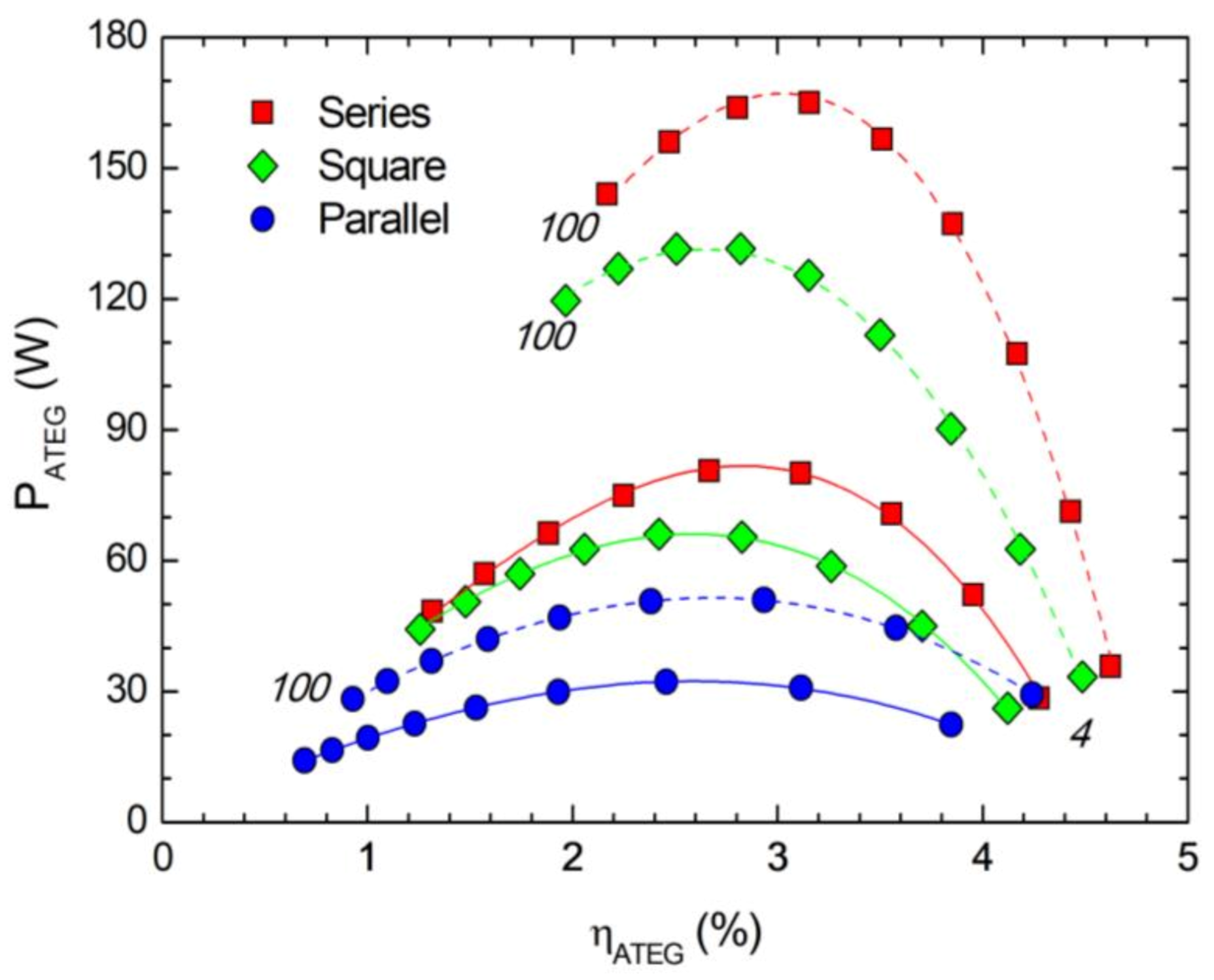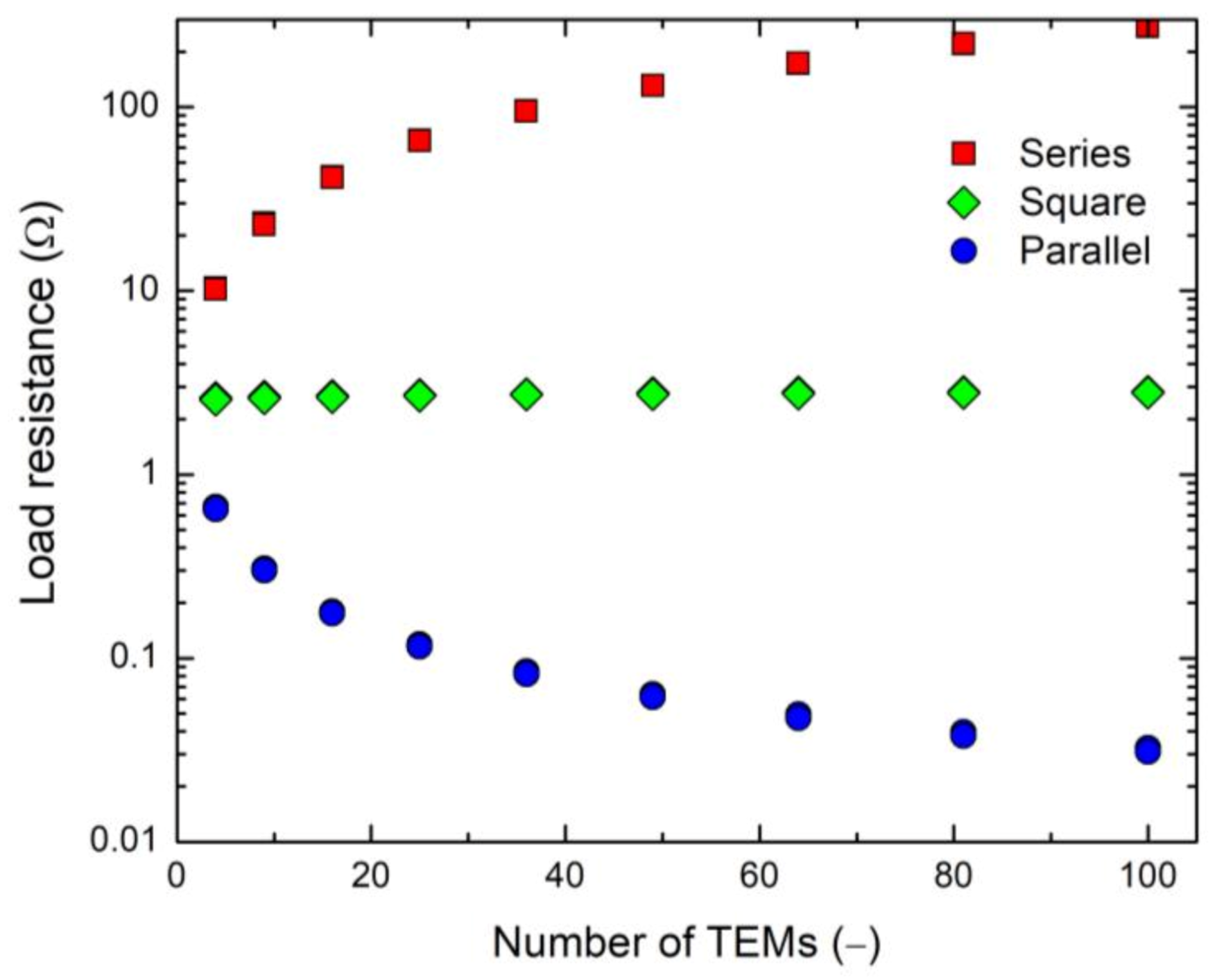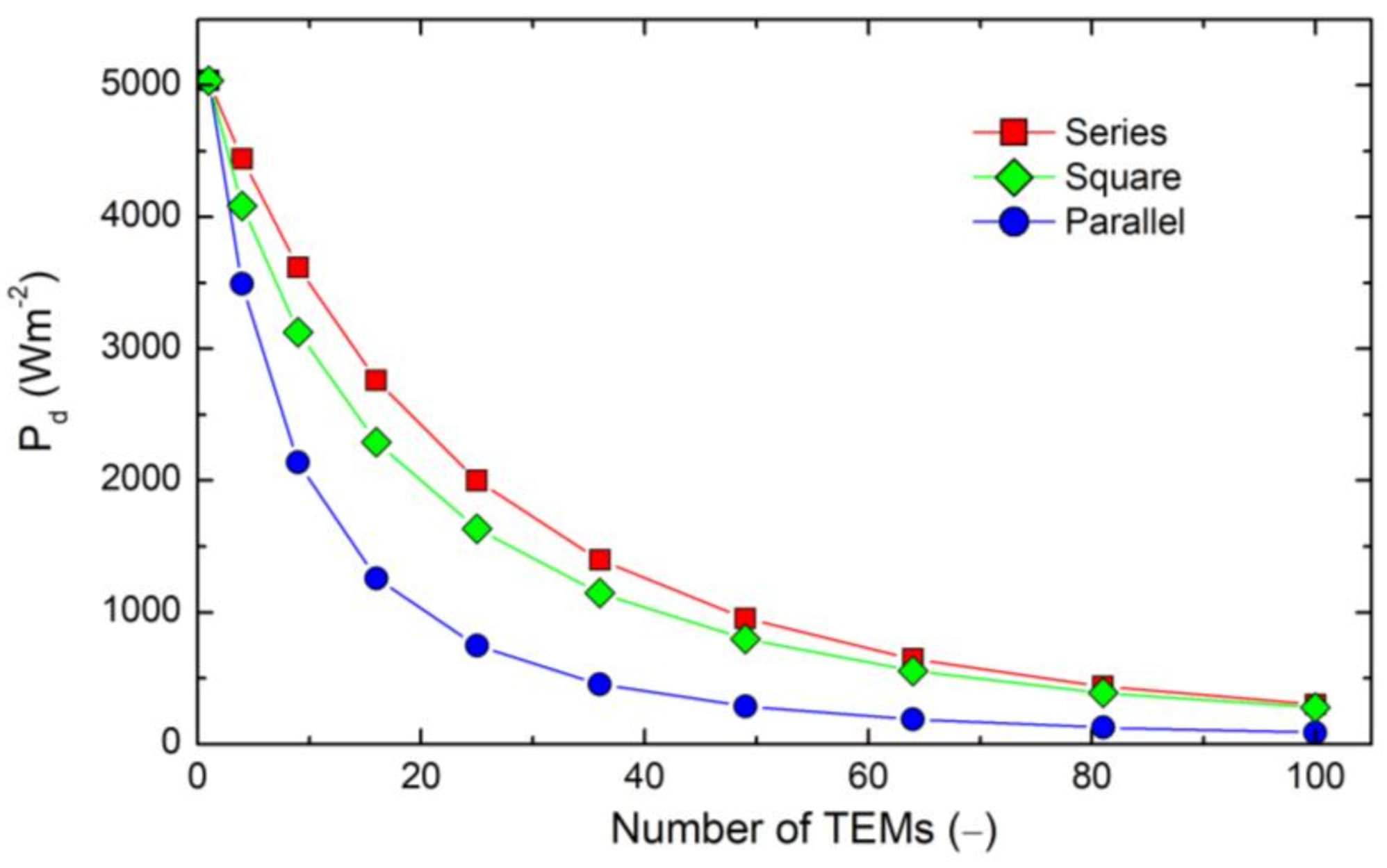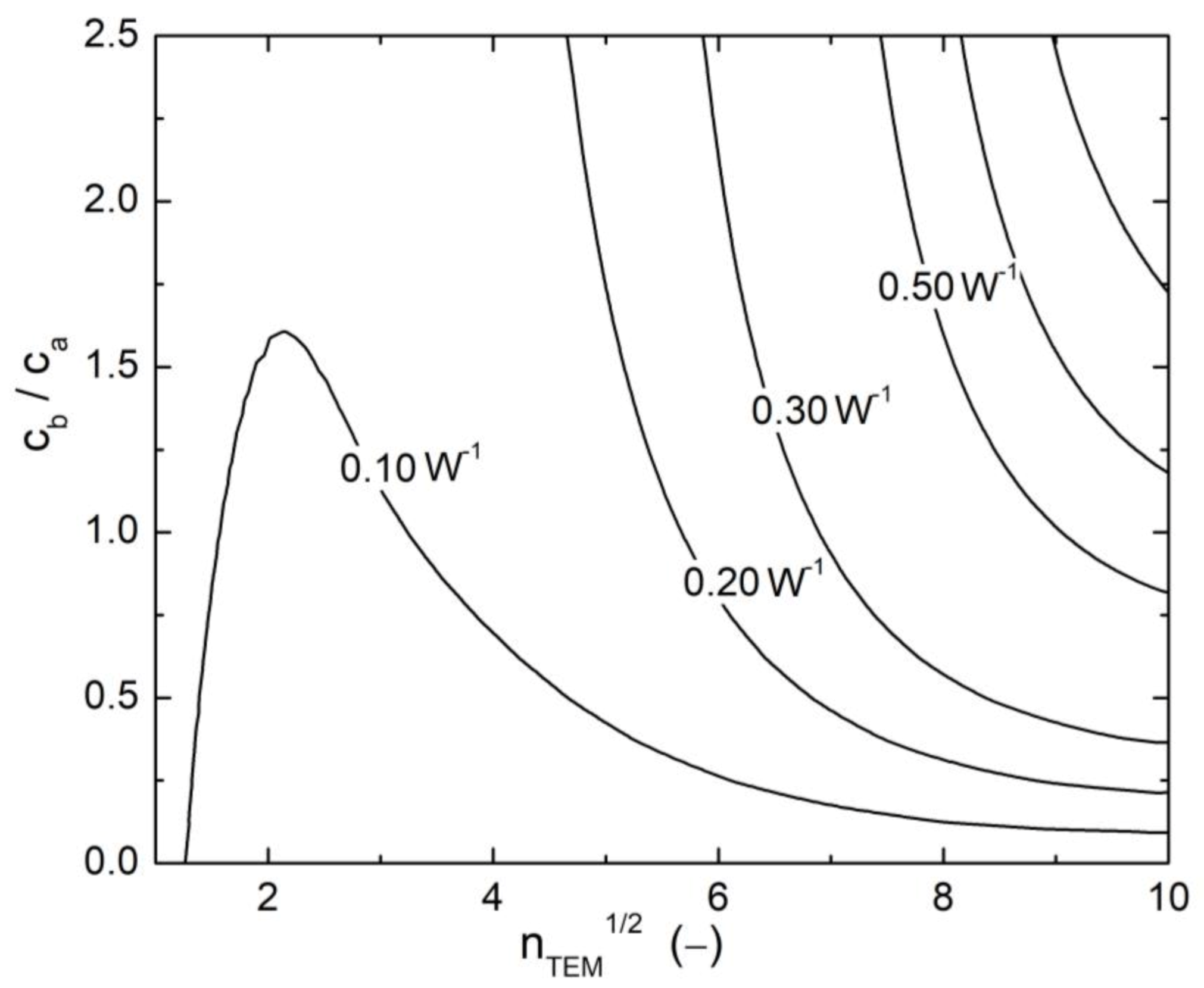1. Introduction
The shift towards an electrified mobility will imply the coexistence of transportation modes based on different powertrains. In the mid-term, the long-distance road transport of goods will continue relying on vehicles with internal combustion engines [
1]. However, regulatory requirements will seek to pursue cleaner and more efficient devices, with national and supranational organizations planning strategies to promote new technologies to achieve such goals. As an example, several calls of the European Union funding programmes have tackled different aspects involved in the issue of green mobility of road vehicles [
2].
It is well known that approximately 1/3 of the fuel primary energy employed in internal combustion engines is lost through the exhaust gases [
3]. Among the techniques aimed to partially recover this energy, thermoelectricity may be a feasible candidate since it directly converts heat into electricity without the need of moving parts. Commercial thermoelectric generator modules (TEMs) consist of pairs of
n-type and
p-type semiconductor legs electrically connected in series and thermally in parallel. Once interconnected via copper junctions, all these legs are packed in between two electrical insulator plates, usually made of ceramic. A single TEM of dimensions 40 × 40 × 3.5 mm may contain on the order of 100 legs, being able to generate < 10 W with a 240 Wm
−2 heat flux and an overall energy efficiency below 5% (see, e.g., [
4]).
To conform to market demand, an automotive thermoelectric generator (ATEG) based on commercial TEMs requires a large number of TEM units. For example, the number of TEMs used in ATEG prototypes for passenger cars ranged from 8 to 80, substantially varying in the form on how single units are spatially distributed. Stobart et al. [
5] analyzed an ATEG with 16 TEMs in a square configuration pattern (4 columns each one with 4 TEMs, where the term column refers to a location perpendicular to the exhaust pipe direction), reaching a maximum output power of 30 W. Massaguer et al. [
6] tested a plane parallel ATEG with 12 TEMs distributed in 3 columns each one with 4 units. Comamala et al. [
7] tested a compact radial design with 10 TEMs located at the same exhaust pipe cross section point. Fernández-Yáñez et al. [
8] and Ezzitouni et al. [
9] designed a plane parallel ATEG with 80 TEMs distributed in 8 columns each one with 10 units. In heavy duty vehicles, the number of TEMs employed in an ATEG often increases. Frobenius et al. [
10] employed 224 TEMs packed at the exhaust pipe of a commercial heavy duty truck. Wang et al. [
11] experimentally analyzed the performance of an ATEG formed by four units of 60 TEMs distributed in 6 columns each one with 10 TEMs. However, smaller ATEGs have been tested in large capacity engines, as in Lan et al. [
12] who analyzed an ATEG with 20 TEMs (5 column each one with 4 TEMs) in a 6.6 L displacement diesel engine.
As expected, the configuration of the electrical connection between TEMs modifies the output power (see, e.g., [
13]). Series electrical configuration between TEMs appears to be the most adequate, as Montecucco et al. [
14] suggested in the experimental analysis of 3 TEMs. In comparison with a parallel connection, they found that the output power of a series one was closer to the value obtained when maximizing the TEMs independently. Once the operating point is fixed, adding TEMs to an ATEG increases the output power, eventually reaching a maximum value beyond which the use of more TEMs decreases the overall energy generation. This effect arises because the added TEMs extract low heat flux values, so their contribution to energy generation by the Seebeck effect is low. At the same time, their Joule heating term is high due to the non-negligible current as they are electrically connected to the rest of the system. Therefore, the overall energy generation reduces in comparison with a case with less TEMs [
15]. Stevens et al. [
16] numerically found that the point of maximum output power was higher when using a series electrical connection between TEMs rather than parallel.
Mixed series-parallel electrical configurations between TEMs in an ATEG have also been investigated. Quan et al. [
17] experimentally analyzed the implications of using different electrical connections in an ATEG formed by 64 TEMs. The pure series connection was superior than the pure parallel one in terms of energy generation. However, they found a mixed configuration that was able to increase by a 9% the output of the series case. Similarly, Fang et al. [
18] experimentally and numerically studied an ATEG with 60 TEMs. They obtained a 20% increase in the output power of the series electrical configuration by using a mixed electrical topology.
Li et al. [
19] numerically investigated the effect of changing the number and distribution of TEMs in an ATEG. The ATEG was formed by 17 columns. Response surfaces of maximum electrical output power and energy conversion efficiency were obtained as a function of the number of TEMs employed in different columns. A multi-objective genetic algorithm was applied to find the optimal distribution pattern that increased by a 53% the initial design. The optimal design used different number of TEMs in different columns.
The effect of inhomogeneous temperature distribution in ATEGs formed by large number of TEMs was numerically investigated by Tao et al. [
20]. In an ATEG formed by 8 columns each one with 4 TEMs, these authors found a clear decrease of output power in individual TEMs located along the exhaust gas flow direction. However, those TEMs located in the same column had similar performance values. These results were experimentally confirmed by Quan et al. [
21] in the analysis of the ATEG formed by 240 TEMs already analyzed in [
11].
The effect of the spatial distribution of TEMs (thermal connection) on the ATEG energy generation was also studied by Cózar et al. [
15] who numerically analyzed three spatial distributions of TEMs: full series, square and full parallel. They found that the full series topology (all TEMs in a row along the exhaust pipe) reached the highest value of energy generation. In contrast, the full parallel one (all TEMs located in a cross-sectional plane of the exhaust pipe; i.e., in one column) had the lowest value of energy generation.
These previous studies were mainly focused on how the output power changed when using different electrical and thermal connections between TEMs. However, additional information is needed to assess the commercial feasibility of applying this technology to recover waste heat in internal combustion engines. In particular, values of global energy conversion efficiency and electrical magnitudes such as voltage and current are very relevant when the ATEG is finally integrated into the vehicle management system. Therefore, the objectives of the present work were (1) to obtain the energy conversion efficiency and (2) to analyze voltage and current for different configurations of TEMs in ATEGs formed by 4 to 100 TEM units.
Following Cózar et al. [
15], three different thermal configurations were here numerically studied: full series, square and full parallel. Full series corresponded to a distribution in which TEMs formed a row aligned with the exhaust pipe. In full parallel all TEMs occupied the same exhaust pipe cross-sectional plane. In the square configuration, we distributed an equal number of TEMs per row than per cross-section. The latter configuration constrained the cases analyzed to ATEGs with a number of TEMs equal to the square of an integer number.
On the other hand, the electrical connection between TEMs was series in the thermal series case, mixed series-parallel in the thermal square case and parallel in the thermal parallel case, though other electrical connections were also analyzed and discussed in
Section 2. The electrical circuit was closed with a load resistance, whose value was varied to maximize the output power as explained in
Section 2. The simulation of the system, including the optimization procedure for the load resistance, was carried out with the GT-SUITE software detailed in
Section 2. For each ATEG configuration, two different operating conditions representative of vehicle engine regimes were used.
3. Results
Thermal series, square and parallel configurations implied different working conditions at the TEM level. This was already observed in Cózar et al. [
15], though they only focused on the electrical output power and TEM values of voltage and current. In terms of extracted heat from the exhaust fumes, TEMs at the same column absorbed an equal amount, as expected (see, e.g., the square configuration in
Figure 4). This led to a continuous decrease of the energy available in the exhaust along the flow direction. Therefore, the heat flux across the TEMs diminished in the downstream path and, as a consequence, the temperature difference at both sides of TEMs also reduced.
Figure 4 illustrates these phenomena for an ATEG with 64 TEMs working at operating point #2.
For the series pattern, the heat flow at the TEM hot side varied from 175 W at TEM #1 to 41 W at TEM #64. In terms of temperatures, values were hot side temperature
482 K and temperature difference
175 K at TEM #1 and
324 K and
29 K only at TEM #64. Since the effective Seebeck coefficient decreases as a function of temperature, the conversion rate of heat into electricity was highly penalized in those TEMs located downstream. Therefore, individual TEM output power substantially reduced along the downstream pipe direction, as observed in
Figure 4. Thermal series configuration for any number of TEMs always reported a monotonically decreasing convex behavior of output power
, heat flows
and
, temperatures
and
, temperature difference
, and voltage
as a function of the number of TEMs. However, local energy conversion efficiency
values behaved as a monotonically decreasing concave function since the rate of change of output power was higher than the rate of change of heat flow (see the series configuration in
Figure 4). This meant that local efficiency values tended to abruptly decline once moving towards the downstream end of the ATEG. Note that negative values of local output power and, hence, of efficiency, might occur at TEMs located at the tail of the ATEG, even when they had positive values of heat flux and hot minus cold side temperature differences. This effect was caused by a Joule heating term that exceeded the Seebeck generation term in Equation (3). This was a consequence of having all TEMs electrically interconnected, so the current flow through the downstream TEMs was substantially larger than that expected in case of being electrically independent from their neighbors. In the latter assumption, current would be much lower, and positive (though very low) values of local output power and efficiency would be attained. However, the purpose here was to assess the feasibility of integrating an ATEG into the vehicle management system so we ignored the contribution of individual TEMs disconnected from the main electrical line.
The square configuration had a trend similar to that of the series one although modulated by the effect of arranging some TEMs in columns. All TEMs located at the same cross-sectional plane provided equal output values, so there was not a strict monotonic decrease of the reported variables. It implied that peak values of output power, efficiency, temperature difference, heat flux, voltage, etc., were lower than those obtained in the series configuration. But, at the same time, minimum values of such variables were higher than those of the series topology. In the particular case of an ATEG with 64 TEMs with operating point #2 (
Figure 4), none of the TEMs contributed negatively to the global output power, which contrasted with the findings of the series configuration. Note also, that energy conversion efficiency values of TEMs in upstream columns slightly changed, with differences increasing as moving to downstream locations. Finally, the thermal parallel configuration implied a uniform behavior for all TEMs in the ATEG since they were exposed to the same heat and cold flow conditions. In this case,
.4 K for all TEMs, a value much lower than that obtained for the first TEM in the pure series configuration. This was a consequence of the pure parallel pattern that extracted all the energy from the exhaust gases in a single point. This procedure was not as effective as to gradually take out the heat from the exhaust fumes along the pipe direction (series configuration). For example, the overall heat flux extracted at a single point in the parallel configuration in
Figure 4 was 2815 W. This was equally distributed among all 64 TEMs, giving a heat flux per TEM of 44 W. In contrast, the maximum heat flux extracted at a single point was 175 W at TEM #1 in the series case. In the series configuration, the addition of all the heat extracted by TEMs reached a total amount of 5844 W, much larger than in the thermal parallel configuration.
We applied a descriptive statistics analysis to both output power and efficiency datasets for all the ATEGs analyzed.
Figure 5 shows the results for the operating case #2. The end of whiskers in box charts referred to the maximum and minimum values of the dataset. The open square indicated the average value. Individual points were shown for the case of an ATEG with only 4 TEMs since a box chart would be meaningless with such a small number of data points. The statistical analysis of the data shown in
Figure 4 corresponded to the box charts for the case of an ATEG with 64 number of TEMs in
Figure 5. Note that all TEMs had the same outputs in the thermal parallel configuration, so a single point in
Figure 5 represented this case.
Upper and lower boxes and whiskers were similar in ATEGs with a low number of TEMs (<25) indicating a regular data distribution with no dominant trend and a median very similar to the average value. As the number of TEMs employed in the ATEG increased, boxes became taller revealing a raise in data variation, though it eventually shortened for output power values when using very high number of TEMs. The latter was caused by the fact that the variability at the lower range was limited since large negative output power values were not possible. At the same time, boxes were uneven in size, meaning a more variable nature in the upper half of values, for output power, and in the lower half of values, for energy conversion efficiency. The very long lower whisker observed in the efficiency data was a direct consequence of the rapid decline of their values in TEMs located near the downstream end of the ATEG, as shown in
Figure 4 for an ATEG with a number of TEMs
= 64. The thermal square configuration clearly showed a more uniform behavior than the series one.
Global values of output power
and energy conversion efficiency
were calculated with Equations (6) and (8). Results confirmed that there existed a threshold number of TEMs assembled in an ATEG beyond which the total output power extracted
decreased (see
Figure 6). This effect was not only observed in the series configuration, when downstream TEMs might negatively contribute to the overall output power value, but also arose in the pure parallel configuration in which all TEMs behaved identically. In this case, as the number of TEMs employed in the ATEG increased, the heat flux absorbed per TEM decreased, leading to small temperature differences, output power and energy conversion efficiency. Thus, the energy generation tended to zero as the number of TEMs tended to infinity. A greater output power was always attained with the series configuration, though the obvious mismatch in working conditions at the TEM level. In the low regime scenario (operating point #1), the maximum output power was
= 80.5 W with an ATEG with
= 36 for the series configuration. For the very same conditions, the square configuration was able to reach
= 66.1 W with the same number of TEMs, and the parallel configuration generated a maximum of 32.2 W attained with
= 16 (see
Figure 6). The 18% decrease in maximum output power between the series and the square configurations was slightly increased in the high regime scenario (operation point #2). In this case, the series case produced up to 165.0 W using
= 49, whereas the square one reached 131.5 W with the same number of TEMs (20% decrease). The maximum output power of the parallel configuration was 69% below that of the series one, being only 50.9 W at the
= 16 case. Energy conversion efficiency values were maximum at the smallest ATEG device, monotonically decreasing as a function of the number of TEMs used in the ATEG.
It was interesting to observe that, despite the large variations of energy generation reported for different configurations, all cases predicted a similar value of
at maximum
conditions.
Figure 7 shows the ATEG output power as a function of the ATEG energy conversion efficiency for the working conditions of
Table 2. Lines in
Figure 7 correspond to cubic polynomials fitted to data constrained to intercept the origin of coordinates. Coefficients of determination were above 0.99 for all cases. For operating point #1, the overall efficiencies of the ATEG that produced the maximum output power were 2.7%, 2.4% and 2.5% in the series, square and parallel configurations, respectively. For the operating point #2, these values were slightly greater, being 3.2% (series), 2.8% (square) and 2.9% (parallel). Thus, maximum output power values were achieved in ATEG designs whose global energy conversion efficiency was on the order of 3%, irrespective of the model configuration.
The full integration of thermoelectric generators in a vehicle is a complex task, especially in terms of managing the energy generation [
33]. Several control strategies about using this additional power source have been proposed (see, e.g., [
34,
35]). Values of electrical variables such as current, voltage and load resistance are key to assure a smooth technical implementation into the vehicle system. Output voltages on the order of 12 V–24 V and load resistances with small variations between different regimes would favor such an integration process. The required load resistance
to maximize the output power when the number of TEMs was fixed had more than one order of magnitude variation in both series and parallel configurations (see
Figure 8). For the series case,
ranged from 10 Ω (
= 4) to 273 Ω (
= 100). In comparison,
for the parallel layout varied from 0.67 Ω (
= 4) to 0.03 Ω (
= 100). These differences contrasted with the narrow band of
needed to maximize the output power in the square configuration. In this case,
changed from 2.6 Ω (
= 4) to 2.8 Ω (
= 100) only. Previous
values corresponded to those for the operating point #2, though very small variations were found when analyzing the operating point #1.
Global current and voltage at ATEGs with different configurations and number of TEMs but at the
that maximized the output power were also investigated (
Figure 9). The series configuration generated low currents and very high voltages, reaching 147 V when using
= 49 at the operating point #2 (global maximum output power was 165 W, see
Figure 6). On the contrary, the full parallel configuration produced high currents and very low voltages. For example, current was 16.8 A and voltage 3.0 V in case
= 16 at the operating point #2 (50.9 W in
Figure 6). In addition, both series and parallel configurations had large variations in current and voltage as a function of the number of TEMs used in the ATEG (see
Figure 9). However, the thermal square configuration supplied a remarkable steady values of current and voltages for all the range of ATEGs studied. Thus, current varied from 3.6 A to 6.9 A and voltage from 9.3 V to 19.1 V at operating point #2 using designs from
= 4 to
= 100. These values where slightly reduced at operating point #1.
Besides the technical requirements for an easy integration into the vehicle system, the adoptability rate of ATEGs strongly depends on economic aspects. Above, we analyzed ATEGs that largely varied in the number of TEMs
employed (from 1 to 100), so the question here was how did the cost of an ATEG increase as a function of
? To answer it, we calculated the output power density
by dividing the total output power by the area occupied by TEMs in the ATEG. Since the solution sought intended to be general, final variables were normalized to a reference value. This was chosen as the case of an ATEG formed by a single TEM element (i.e.,
= 1), for which we obtained an output power of 8.1 W and 9.6 W under operating point #1 and #2 conditions, respectively. As expected,
was maximum for
= 1, decreasing with the number of TEMs (for operating point #1 data see
Figure 10).
A non-linear fit was applied to the maximum power density data per ATEG shown in
Figure 10 as a function of
, giving
with
= 517.45 Wm
−2,
b = 4696.62 Wm
−2 and
r = 0.04529 with a coefficient of determination R
2 = 0.999. This expression was used to estimate the cost per watt of the ATEG as a function of
. The manufacturing cost of the TEG depends on the number of TEMs employed. We assumed a linear relationship of the total cost
as a function of
, being
where
was the part of the cost directly proportional to the number of TEMs employed in the assembly (for example, direct cost of TEM units and cost of elements that were a function of the ATEG size, which is directly proportional to
, such as the heat absorber, the water heat sink, minor wiring, etc.), whereas
was the invariable, in terms of
, contribution to the total cost (for example, openings and endings of the ATEG pipe, load resistance, main wiring, etc.). Then, the cost per watt was
where, by definition of
, the output power was
with
(= 40 × 40 mm) the surface area of a single TEM.
Figure 11 shows the cost per watt
normalized to the cost of a TEG formed with a single TEM
,
applying the
function previously fitted to the series configuration at operating point #1. However, the conclusions extracted from this analysis were not limited to this particular case, since, from
Figure 10, similar dependences of
on
were expected for different configurations and working conditions.
In the limit of an invariable cost tending to zero (or, conversely, of a very high proportional cost),
whereas for high values of the invariable cost, the cost per watt tends to a constant value
. The minimum cost per watt generated was found at low values of
, but not at
= 1. A good design strategy to reduce the cost per watt would rely on reducing the proportional cost
as much as possible in order to be on the lower right region of
Figure 11.
4. Conclusions
We analyzed the consequences of modifying the spatial distribution of individual TEMs in ATEGs on global energy conversion efficiency and electrical variables (current, voltage and external load resistance). Three different layouts were studied: series (TEMs arranged in a single row aligned with the exhaust flow direction), parallel (TEMs arranged in a single column along a cross-sectional plane of the exhaust pipe) and square (same number of TEMs in rows than in columns). The number of TEMs used in the ATEGs varied from 4 to 100. The electrical connections between individual TEMs followed the spatial configurations (series circuit for the series thermal; parallel circuit for the parallel thermal; column parallel and row series circuit in the square thermal). The external load resistance was tuned to maximize the output power in all configurations. Two working conditions were evaluated.
Results confirmed that the pure series topology provided a superior output performance in comparison with other configurations. However, a very rapid decline in TEM efficiency was observed towards the downstream end of the ATEG. In ATEGs with a high number of TEMs, TEMs located farther from the beginning (exhaust upstream) of the ATEG even reached negative efficiency values, penalizing the global performance of the system. In comparison, the square configuration had a remarkable lower variability, though its generation was around 20% lower. The parallel configuration provided uniform working conditions for all TEMs though generating on the order of 70% less than the series case for the same number of TEMs used.
For a fixed spatial configuration (series, square or parallel), the ATEG whose number of TEMs produced the uppermost output power had a global efficiency on the order of 3% independently of the layout. Thus, from the point of view of the global energy conversion efficiency, all configurations were very similar. The parallel case, for example, generated the less since it extracted the less energy from the exhaust gases. In some cases, this feature may be of interest in order to assure, for example, a minimum enthalpy of exhaust fumes at ATEG’s outlet.
Electrical output variables were monitored. Current through the load resistance and voltage at its ends for both series and parallel configurations had large variations depending on the number of TEMs employed in the ATEG. Values above 200 V and below 10 V (series) and above 30 A and below 5 A (parallel) were obtained when using different number of TEMs. However, the square configuration supplied on the order of 15 V and 5 A for most of values. In addition, the optimized load resistance value for this configuration required very small variations as a function of the number of TEMs employed. Finally, a cost analysis of ATEGs with different number of TEMs revealed the possibility of having a minimum cost per generated watt in ATEGs with low values.
The viability of an ATEG highly depends on its ability of being integrated into the vehicle management system. From the above, we recommend the square thermal configuration. In spite of its lower generation with respect to the series configuration, its nearly steady output of electrical variables regardless of the number of ATEGs used (or, equivalently, turned on), and its realistic physical dimensions makes it a reasonable candidate for this technology.
